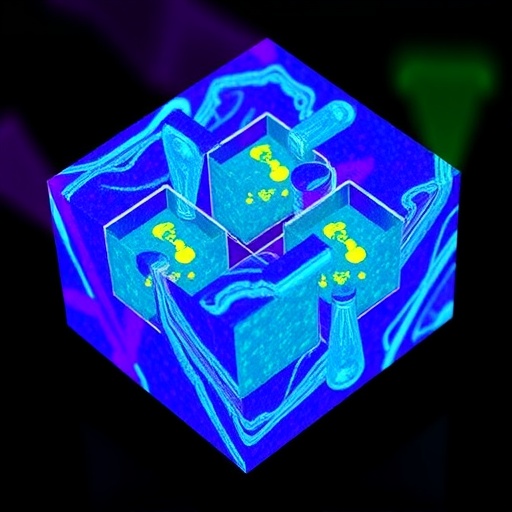In a groundbreaking study published in Environmental Science and Pollution Research, researchers reveal a novel approach to combatting the pervasive issue of dye pollution in waterways. With industries continuously discharging colored effluents containing hazardous dyes into the environment, the search for effective remediation strategies has become imperative. This study unveils an innovative biopolymer-based composite made from chitosan and ternary metal selenide constructs. The research, conducted by a team led by Aziz, Farhan, and Khan, presents a pathway for the photocatalytic degradation of two prominent synthetic azo dyes: sunset yellow and acid black.
The researchers began their investigation by acknowledging the alarming increase in dye pollution across global water bodies. Such pollutants not only tarnish natural resources but also pose severe risks to aquatic ecosystems and human health. Synthetic dyes, particularly azo dyes, represent a significant portion of the wastewater generated by textile, food, and pharmaceutical industries. Hence, the implications of developing an efficient photocatalytic process cannot be overstated. The utilization of a chitosan-ternary metal selenide composite sets a robust precedent for eco-friendly methodologies in wastewater treatment.
Chitosan, a biopolymer derived from chitin, has garnered attention in recent years for its natural biodegradability, non-toxic nature, and biocompatibility. By integrating chitosan with ternary metal selenides, the researchers aimed to enhance photocatalytic properties while maintaining sustainability. The choice of ternary metal selenides was pivotal, given their unique electronic and optical characteristics, which can significantly boost the efficiency of photocatalytic reactions under light irradiation.
Employing advanced response surface methodology (RSM), the researchers meticulously optimized the synthesis conditions of the chitosan-ternary metal selenide composite. Through a series of experiments, they varied parameters such as pH, temperature, and precursor concentration. RSM not only expedites the optimization process but also allows for a multifactorial analysis that illuminates the interplay between these critical variables. The application of such sophisticated methodologies enhances the reproducibility and reliability of the findings.
Upon constructing the composite, the researchers undertook rigorous characterization using various analytical techniques, including X-ray diffraction (XRD), scanning electron microscopy (SEM), and energy dispersive X-ray spectroscopy (EDS). These characterizations confirmed the successful integration of chitosan with metal selenides, revealing a porous structure that is advantageous for photocatalytic activity. The morphology observed via SEM highlighted the composite’s high surface area, which is crucial for increased interaction with the dye molecules during degradation processes.
Following the synthesis and characterization phases, the research team launched into the photocatalytic performance evaluations of their composite. By exposing the composite to UV light in the presence of sunset yellow and acid black dyes, they carefully monitored the degradation efficiency over time. The results were nothing short of impressive, with significant dye degradation observed within relatively short exposure durations. The photocatalytic degradation pathways were elucidated, showcasing the breakdown mechanisms employed by the composite under UV irradiation.
In a further demonstration of the composite’s effectiveness, the researchers explored the influence of various operational parameters on the photocatalytic performance. Factors such as initial dye concentration, catalyst dosage, and light intensity were meticulously analyzed. Their findings offered valuable insights into optimizing conditions for maximal degradation, ensuring that this innovative technology could be adapted for real-world applications.
The implications of their findings extend far beyond just photocatalytic degradation technology. The successful integration of a biopolymer with photocatalytic agents exemplifies a shift towards sustainable practices in environmental remediation. As the scientific community grapples with the dilemma of balancing industrial growth with ecological sustainability, the development of such composites may pave the way for future innovations in waste treatment processes.
Ecotoxicological assessments provided additional layers of insight, with the researchers demonstrating a marked decrease in the toxicity of treated effluents. By evaluating the cytotoxic effects of the dye-contaminated water pre- and post-treatment, they affirmed that the photocatalytic process not only effectively decolorized the dyes but also rendered the water less harmful to aquatic organisms. This vital perspective drives home the significance of integrated approaches to pollution control.
Future studies are expected to focus on scaling up the synthesis process of this composite material, as well as exploring its efficacy against a broader spectrum of dye pollutants. The promise inherent in combining chitosan with other photocatalytic materials introduces exciting avenues for research and industrial application alike. Researchers will likely delve deeper into the mechanistic pathways of photocatalysis to unveil new strategies for optimization.
In addition to its hope for practical applications in wastewater treatment, this study serves as a clarion call for further exploration and investment in biopolymer-based technologies. With the world facing unprecedented environmental challenges, this research heralds the dawn of innovative solutions that marry sustainability with effective pollution management. The implications reverberate not only through academic circles but also resonate across industries aiming for greener processes.
Through their meticulous approach, Aziz, Farhan, and Khan have not only contributed significantly to the growing body of knowledge surrounding photocatalytic technologies but have also ignited dialogue on sustainability in chemical processes. As researchers, policymakers, and industries alike rally against environmental degradation, studies like these underscore the crucial intersection of innovation and responsibility.
In conclusion, the research presents a promising avenue towards addressing one of the modern world’s pressing environmental concerns. The effective construction and application of the chitosan-ternary metal selenide composite exemplify a holistic approach to pollution remediation. By bridging the gap between academia and real-world application, the researchers invite collective action toward protecting our valuable water resources in the face of relentless industrial expansion.
Subject of Research: Development of biopolymer-based composites for photocatalytic degradation of dye pollutants.
Article Title: Facile construction of chitosan-ternary metal selenide biopolymer-based composite for photocatalytic degradation of petroleum derive sunset yellow and acid black azo-dyes using response surface methodology RSM.
Article References:
Aziz, T., Farhan, M., Khan, A. et al. Facile construction of chitosan-ternary metal selenide biopolymer-based composite for photocatalytic degradation of petroleum derive sunset yellow and acid black azo-dyes using response surface methodology RSM.
Environ Sci Pollut Res (2025). https://doi.org/10.1007/s11356-025-36811-8
Image Credits: AI Generated
DOI: 10.1007/s11356-025-36811-8
Keywords: photocatalysis, chitosan, metal selenides, azo dyes, wastewater treatment, environmental remediation, sustainable technology.




